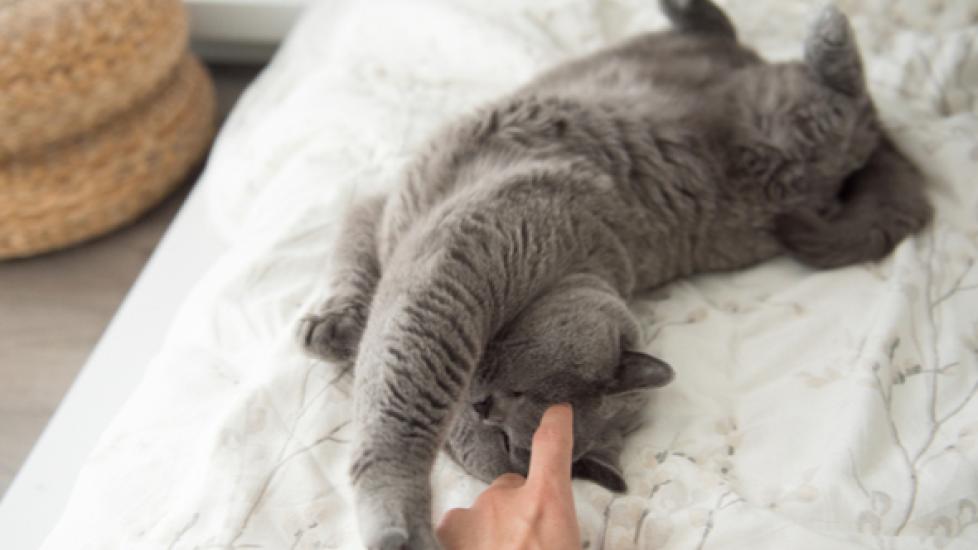Cat Affection: Nature or Nurture?
Reviewed and updated for accuracy on July 2, 2018, by Jennifer Coates, DVM.
Nature or nurture? That’s the question when it comes to cat affection. The simple answer is that it’s both.
Dr. Shannon Stanek, DVM, owner and head veterinarian of Exton Vet Clinic in Pennsylvania, says that similarly to humans, it is personality and upbringing that determines levels of cat affection.
Stanek emphasizes that nature and nurture are of equal importance, and that the first four months of life matter the most. “Cats raised with people during that time tend to be more affectionate and attentive,” she says. “We get scared, feral kittens all the time. They’re not affectionate because they’ve never had human interaction. As we handle and love them, they learn to enjoy and even seek out human contact.”
Certified cat behavior counselor Mieshelle Nagelschneider, also known as “The Cat Whisperer™,” believes that there are many factors that play a role in cat behavior and levels of cat affection. “I’ve seen cats from the roughest environments be some of the most loving and affectionate you could imagine,” says Nagelschneider. “I’ve also seen cats raised in ideal conditions that are irritable and reclusive.”
Handle With Care
Dr. Stanek emphasizes the importance of the early socialization stages in raising a kitty. She says that teaching them how to play appropriately with cat toys is essential.
“Respect them, love them, handle them and expose them to lots of people as they develop,” explains Dr. Stanek. “Teach them that it’s not ok to scratch and nip. Many owners think it’s cute when kittens pounce and scratch or bite without understanding that this is hunting behavior. Letting them behave that way as kittens can result in a more aggressive cat as they grow and develop. Having a cat-friendly environment with toys they can safely ‘attack’ is a big help.”
Earn Your Cat’s Trust
Respecting a cat’s space and earning their trust is essential to building a strong bond with a cat and encouraging cat affection.
Dr. Stanek says, “When dealing with a non-affectionate adult, being calm and not pushing makes a huge difference. They start to associate you with good things, and trust is gained when conditions are right.”
“If the cat has the basic desire to like people, they can overcome negative situations,” adds Susan Bulanda, certified animal behavior consultant. “Some cats will only trust one or two people and will not be the socialite that other cats can be.”
Create Positive Associations
Cats are adaptable, and it may seem surprising, but you can teach an old cat new tricks.
Bulanda says that getting them used to being handled gently and rewarding them with cat treats during this bonding time helps with grooming, veterinarian visits and overall interaction.
Most importantly, never force a cat to be handled if the cat doesn’t like it. “Some cats need to feel they can get away,” says Bulanda. “Cats don’t forget, and if they have experienced discomfort or fear when being held, they will avoid that situation.”
Pay Attention to Health Concerns
If a cat has a sudden change in behavior, such as becoming non-affectionate or upset when handled, it may be related to an illness or other health issue. When a cat that is normally affectionate becomes aloof or aggressive, it is a good idea to have them checked out by the vet.
Can My Cat Become More Affectionate Over Time?
Nagelschneider believes very strongly that cats can change, having conducted thousands of cat behavior consultations over 20 years. With time and patience, she has seen improvement in cat affection in nearly every case, even with feral cats.
Bulanda also feels there is almost always room for improvement. “Cats show affection in different ways,” she says. “How a cat shows affection is not as critical as the fact that the cat shows affection at all. Cat signs of affection can range from napping near a person to wanting a belly rub. It’s important for the cat to feel safe and comfortable around people if they are not naturally that way.”
Different Breeds for Different Needs
The most affectionate cat breeds, such as Ragdoll or Burmese, are also often considered the friendliest cat breeds. To understand the external and internal factors that contribute to a cat’s personality would take a whole course in genetics, according to Bulanda.
“On a basic level, genetics control a cat’s personality,” she says. “This is why different breeds of cats have specific behavior traits.”
But nurture plays a role as well—how your cat is raised, how much attention is given to them, what their daily activity was like before you brought them home, etc. (especially for older cats, feral cats or cats that went through trauma).
As both Nagelschneider and Dr. Stanek have suggested, it’s not an exact science, so keep nurturing those adorable felines, and see what changes you may (or may not) notice.
Image via Carlos G. Lopez/Shutterstock
